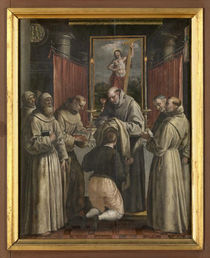The Catholic Defender: Saint Peter Regalado
- Donald Hartley

- Mar 29
- 3 min read
Updated: Mar 29
Deepertruth with special permission and aid with Franiciscan Media, a great team for the Lord

Throughout most of his life, Peter went hungry; he lived only on bread and water. Immediately after his death on March 30, 1456, his grave became a place of pilgrimage. Peter was canonized in 1746. Peter was an effective leader of the friars because he did not become ensnared in anger over the sins of others.
Miraculous stories are told about his charity to the poor. For example, the bread never seemed to run out as long as Peter had hungry people to feed. Throughout most of his life, Peter went hungry; he lived only on bread and water. Immediately after his death on March 30, 1456, his grave became a place of pilgrimage.
Peter lived at a very busy time in history. The Great Western Schism (1378-1417) was settled at the Council of Constance (1414-1418). France and England were fighting the Hundred Years’ War, and in 1453, the Byzantine Empire was completely wiped out by the loss of Constantinople to the Turks. At Peter’s death, the age of printing had just begun in Germany, and Columbus’s arrival in the New World was less than 40 years away.
Peter came from a wealthy and pious family in Valladolid, Spain. At the age of 13, he was allowed to enter the Conventual Franciscans. Shortly after his ordination, he was made superior of the friary in Aguilar. He became part of a group of friars who wanted to lead a life of greater poverty and penance. In 1442, he was appointed head of all the Spanish Franciscans in his reform group.
hermitage of Auguilera, where he found the solitude, the poverty and the climate of prayer that he longed for. Already in life he accomplished many miracles and was favored with great mystical gifts. On the day of the Annunciation, in 1453, Peter was transported by the Angels from the monastery of Abrosco to the monastery of Aguilera, where there was an image of the Virgin which he loved much: he collected himself in prayer and then returned to Abrosco to recite the morning prayers, leaving in astonishment the friars of both communities. He died in the odor of Sanctity in Auguilera on March 30, 1456. Peter Regalado was born in Valladolid in 1390 from a noble family of Hebrew descent. After the death of his father, when Peter had just turned 13, his mother granted him permission to enter the Franciscan monastery of his native city. 1390-1456 Saint Peter Regalado
Peter led the friars by his example. A special love of the poor and the sick characterized Peter. Miraculous stories are told about his charity to the poor. For example, the bread never seemed to run out as long as Peter had hungry people to feed. Throughout most of his life, Peter went hungry; he lived only on bread and water.
Immediately after his death on March 30, 1456, his grave became a place of pilgrimage. Peter was canonized in 1746.
Peter was an effective leader of the friars because he did not become ensnared in anger over the sins of others. Peter helped sinning friars rearrange the priorities in their lives and dedicate themselves to living the gospel of Jesus Christ as they had vowed. This patient correction is an act of charity available to all Franciscans, not just to superiors.
Franciscan Rule, and from 1404 he followed him to the hermitage of Auguilera, where he found the solitude, the poverty and the climate of prayer that he longed for. Already in life he accomplished many miracles and was favored with great mystical gifts. On the day of the Annunciation, in 1453, Peter was transported by the Angels from the monastery of Abrosco to the monastery of Aguilera, where there was an image of the Virgin which he loved much: he collected himself in prayer and then returned to Abrosco to recite the morning prayers,
Many miracles were attributed to him while alive, and even more after his martyrdom. Peter was canonized by Pope Innocent IV on March 9, 1253, the fastest canonization in papal history. St Peter the Martyr's feast day is 6 April although his Dominican brothers celebrate it on 4 June.
After his death on March 31, 1456, his grave became a place of pilgrimage. When his body was exhumed 36 years later, at the insistence of Isabella the Catholic, it was found incorrupt and placed in a more precious tomb.
He was beatified by Pope Innocent XI on 11 March 1684, and canonized by Pope Benedict XIV on 29 June 1746.
His feast is celebrated 13 May, the day of the translation of his body. In art he is represented with flames bursting from his heart.
At Peter’s death, the age of printing had just begun in Germany, and Columbus’s arrival in the New World was less than 40 years away.





















Comments